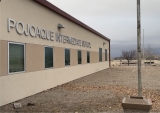-
Category 1
Selected in 2023
-
Grades: 4 - 5
School Setting: rural
Town Population: 2
Student Enrollment: 192
Student Demographics:
Black/African American: 0%
Teacher/Student Ratio: 1:22
White/Caucasian: 0%
Hispanic: 75%
Hawaiian/Pacific Islander: 0%
Asian: 0%
Native American: 20%
Other: 0%
% Reduced Lunch: 57%
% ELL Learners: 10%
Founded: 2007 -
PRINCIPAL:
Theresa Vaisa -
CONTACT:
1574 St. Road 502
Santa Fe, NM 87501
505-455-4504
tlv@pvs.k12.nm.us
Pojoaque Intermediate School
Santa Fe, NM
We thrive on collaboration, data-driven strategies, and commit to holistic student development.
- 1. Tell us about your school’s success.
- PVIS prioritizes student motivation and potential. The dedicated staff analyzes student data, celebrating successes and addressing challenges. Results guide a proactive approach, shared with parents and students, fostering awareness and collaboration. Grade-level teams ensure instructional consistency and problem-solving. PAX emphasizes behavior and learning expectations, enhancing social and emotional well-being, The LA program follows best practices, combining whole group, small group, and computer-based Reading Plus instruction. Monitored by teachers, it targets comprehension, vocabulary, fluency, and reading stamina, involving parents. The multi-tiered reading approach starts with classroom instruction, followed by intensive small-group intervention for below-grade-level students. The final tier caters to special needs and ELL students, providing additional assessment and instruction. Thriving on collaboration, data-driven strategies, and commit to a holistic student development.
- 2. Talk about the greatest contributing factor(s) that promoted positive change in your school.
- Teachers drive positive change through unwavering commitment to collaboration, data-driven decision-making, and transparent communication. They unite to scrutinize data, identify areas for improvement, and implement effective strategies, transforming education into an environment where every stakeholder actively contributes to continuous improvement. Focused on data, innovation, and students' well-being, teachers embrace challenges, replicate successful practices, and proactively address issues through dynamic brainstorming. Transparency and communication are prioritized, with insights shared with parents and students, fostering a strong partnership. Students become empowered participants, supported by caring teachers and engaged parents. The collaborative spirit extends to instructional approaches, ensuring continuity and real-time issue resolution, with grade-level teams using data to develop tailored support for each student's unique needs.
- 3. How has ESEA funding supported the school's success?
- ESEA funding is integral to our school's success, facilitating Professional Learning Development for educators. This support, especially for programs like Reading Plus, empowers teachers with essential skills, aligning professional development with program features. This synergy enhances our instructional approach, particularly in literacy education, fostering a dynamic teaching environment. The continuous learning culture, supported by ESEA funding, positively impacts student engagement and outcomes. This financial support is a cornerstone in cultivating a culture of professional growth, directly contributing to the successful integration of Reading Plus. The connection between targeted funding and educational advancement underscores its critical role, leading to a more enriched learning experience for students and laying the foundation for academic success.
- 4. What professional development activities were used to improve teaching and learning?
- Professional development focuses on leveraging program data for informed decision-making, personalized interventions, & collaborative planning to ensure a responsive teaching and learning approach. Activities include weekly sessions analyzing student work and implementing data-driven instruction using programs like NWEA and Reading Plus. Teachers engage in collaborative discussions to assess student work, identifying patterns, strengths, and weaknesses. PD encompasses effective assessment methods and rubrics for accurate analysis. Teachers interpret data to guide instructional decisions, identify learning gaps, and tailor interventions based on individual student needs. NWEA training provides insights into assessment results and RIT scores, guiding the setting of instructional goals. Reading Plus emphasizes best practices for supporting reading comprehension and fluency, teaching educators to interpret program data, identify struggling readers, adjust interventions, and track progress.
- 5. Talk about the cultural shift leading up to your school's success.
-
A transformative shift in school culture is vital for academic success. Embracing a growth mindset, where challenges are seen as learning opportunities, fosters resilience & a passion for learning. A student-centered approach, tailored to diverse learning styles, promotes inclusivity, individual recognition, & collaboration.
Fostering a culture of curiosity & critical thinking prepares students for the future. Integrating interdisciplinary learning, project-based assessments, & real-world applications enhances engagement & relevance. Effective communication and collaboration among teachers, students, and parents build trust, understanding, and a shared commitment to educational goals.
An empowering school culture, emphasizing ownership and responsibility, fuels academic excellence. Valued, supported, and motivated students are likely to excel and become well-rounded individuals. This collective cultural shift demands commitment, adaptability, and a shared vision for academic success. - 6. How has community involvement strengthened your success?
- Community involvement, notably through programs like Cooking with Kids (CWK), has been instrumental in my multifaceted success. CWK engages parent volunteers, fostering a supportive community that extends beyond the kitchen. These interactions contribute to a positive school environment, offering diverse perspectives. Integrating reading, social studies, and math into hands-on cooking lessons enhances my education, providing practical skills and a deeper understanding of core subjects. This holistic approach not only elevates academic achievements but also instills a genuine love for learning. The regularity of CWK sessions cultivates consistency, positively impacting my time management and discipline. Actively participating in these sessions has honed my ability to balance diverse responsibilities, a vital skill for success in academia and the professional realm.
Stats
-
Category 1
Selected in 2023
-
Grades: 4 - 5
School Setting: rural
Town Population: 2
Student Enrollment: 192
Student Demographics:
Black/African American: 0%
Teacher/Student Ratio: 1:22
White/Caucasian: 0%
Hispanic: 75%
Hawaiian/Pacific Islander: 0%
Asian: 0%
Native American: 20%
Other: 0%
% Reduced Lunch: 57%
% ELL Learners: 10%
Founded: 2007 -
PRINCIPAL:
Theresa Vaisa -
CONTACT:
1574 St. Road 502
Santa Fe, NM 87501
505-455-4504
tlv@pvs.k12.nm.us



